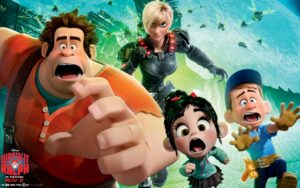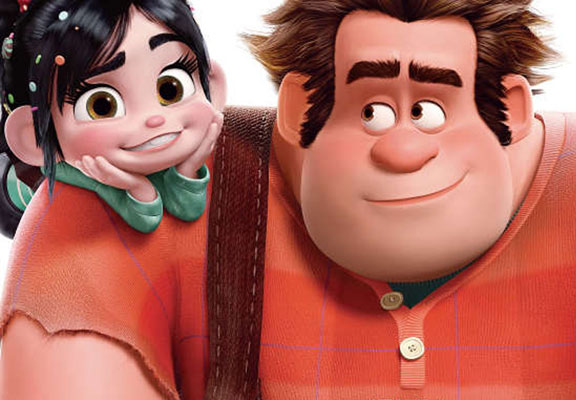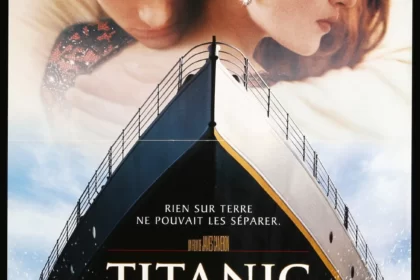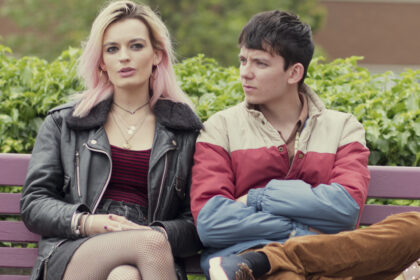(Some spoilers ahead)
Wreck It Ralph, 2012’s Disney Animated Classic, is set in an adorable arcade world where video game characters come to life after hours (à la Toy Story but with electricity, and video game references). In this universe, code becomes synonymous with destiny. Characters must perform according to their game’s specifications, and to fail to do so is to risk putting the game out of order, effectively putting oneself (and one’s colleagues) out of a job. In this context, a disgruntled arcade game villain, Wreck It Ralph, questions his fate, and embarks on a hero’s quest for valour, recognition, respect, and wisdom.
Along the way, Ralph picks up a companion, a fellow outcast from the sickly sweet racing game, Sugar Rush. Although the two make an unusual pair, a big, beefy “bad guy,” and a cute, mischievous, glitchy girl, befriending each other is how these two outsiders finally achieve their goals.

Yet despite the heartwarming friendship that forms, the film is called Wreck It Ralph, not Vanellope von Schweetz. Ultimately, this is not a buddy flick, this is Ralph’s story, and Ralph is the hero. Although the two join up in their quest, her to get into the Sugar Rush race, him to win a medal (and by extension the kindness and friendship of his fellow Fix It Felix, Jr inhabitants), it is really Ralph who goes on the hero’s journey to learn a lesson, save the day, and succeed at convincing the Nicelanders that he’s not the bad guy he’s coded to play. Vanellope, on the other hand, has no such transformation. Although she needs Ralph’s help to achieve her goal, and then again to save her game and herself from destruction, it is not in the same way he needs her influence to discover his path to enlightenment. Through his friendship with Vanellope, Ralph learns to accept the fate his code has given him, all the while proving that he is more than the destructive ogre the Nicelanders see him as. Vanellope, in return, charms her way into Ralph’s heart, and is resultantly rescued from her fate as an excluded glitch by her new friend.
Although women are given interesting characters to play against Ralph and Felix, ultimately both of the leading ladies are confined by traditional Disney-esque tropes. Vanellope is, in the end, less the co-conspirator and more the princess who needs rescuing (quite literally). Calhoun, the tough, military commander from Hero’s Duty, doesn’t exactly come in to save the day as she sets out to do, but alerts the men to the problem so that Ralph can go solve it. She isn’t exactly the tough-as-nails military woman she appears to be, but is shown, by the end, to be a grieving widow who can be softened by new-found love.
Although the film dresses up these tropes with adorable context and a pretty great narrative, with lots of cute gaming references for those of you who know anything about that world, underneath lies some pretty worrying gendered stereotypes.
While men can learn to be good and heroic despite how society views them, women are pretty much stuck being outcasts until men come to offer guidance and friendship. While men learn to accept one another, and be friendly and courteous, not judgmental, women should learn to let their guard down and find a man to love.
Of course, Vanellope is no obvious damsel in distress. She loves herself the way she is, lives to race, and saves Ralph’s life in return, after he saves her game from destruction. But underneath her spunky exterior is a princess who needs help.
I probably wouldn’t have bothered to pull back the layers of her rescue, if the Felix-Calhoun subplot hadn’t seemed so ham-fisted, and awkward. Thinking about how Calhoun enters Sugar Rush planning to save the game from cy-bug infestation, and ends up not only failing to stop the cy-bugs, but also somehow wooed into submission by Felix, I realized that Ralph really does all the heroic saving, and Vanellope, the glitch confined to the infected game, is the object of his rescue. Although the traditional female character is split into two separate bodies (one to be rescued, one to be wooed) the gender dynamics still play out the same old way.
Coming on the heels of Brave, the groundbreaking Pixar animated feature from last spring, Wreck It Ralph takes audiences to a completely different world, with a similar message. We can challenge our fate, we can question the value of our code to dictate how we live our lives. But ultimately, while Brave subverts the expectations that girls must grow up to be loving wives and passive victims and gives us a kick-ass heroine who saves the day, Wreck It Ralph reverts back to the old standby: brave hero rescues girl.
Perhaps Disney is just following its code(s and conventions).
Overall, I really enjoyed this film. It is a cute, at times funny, well-constructed story. I just wish that good stories did not have to rely on tired old gender roles.





